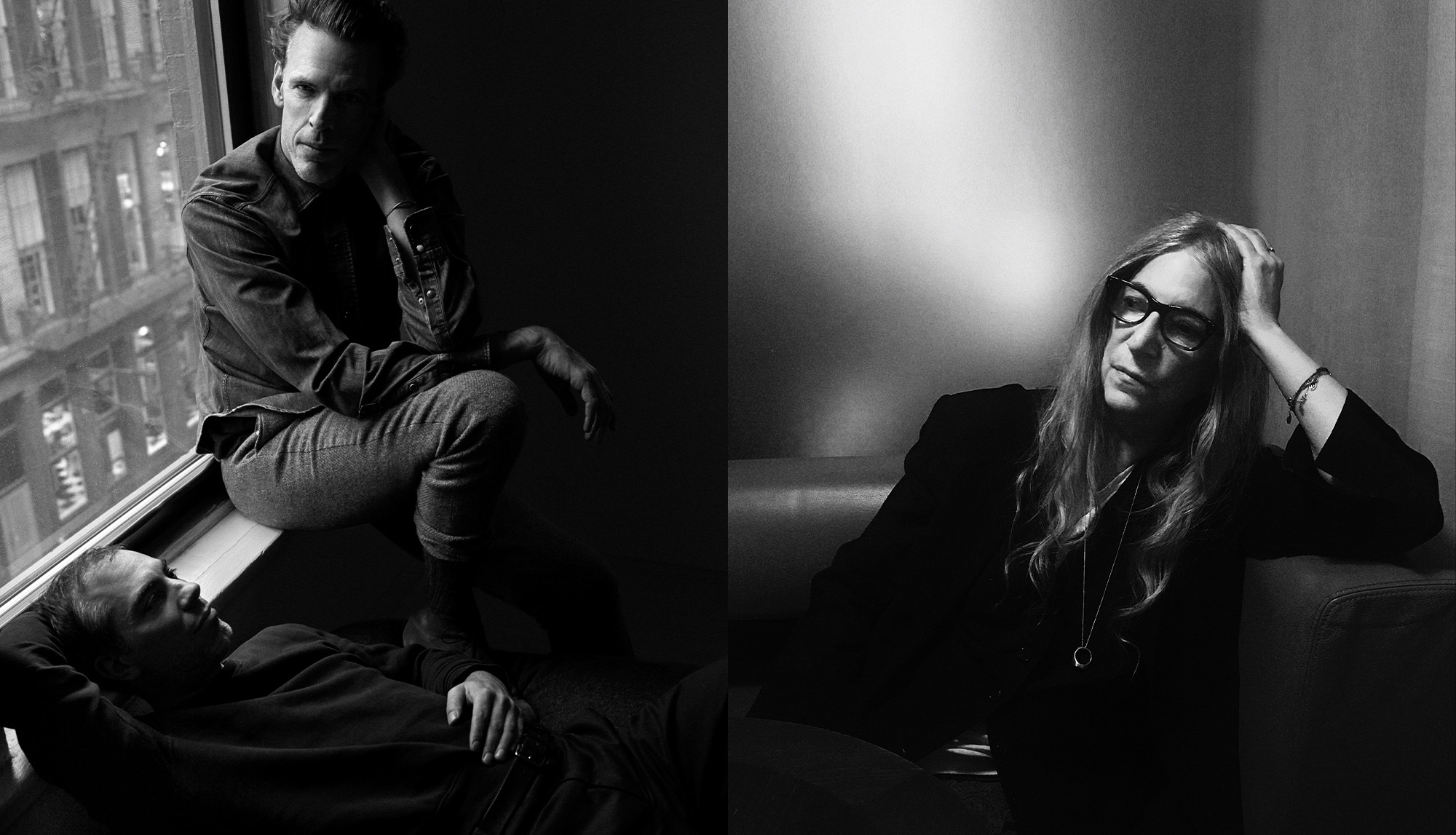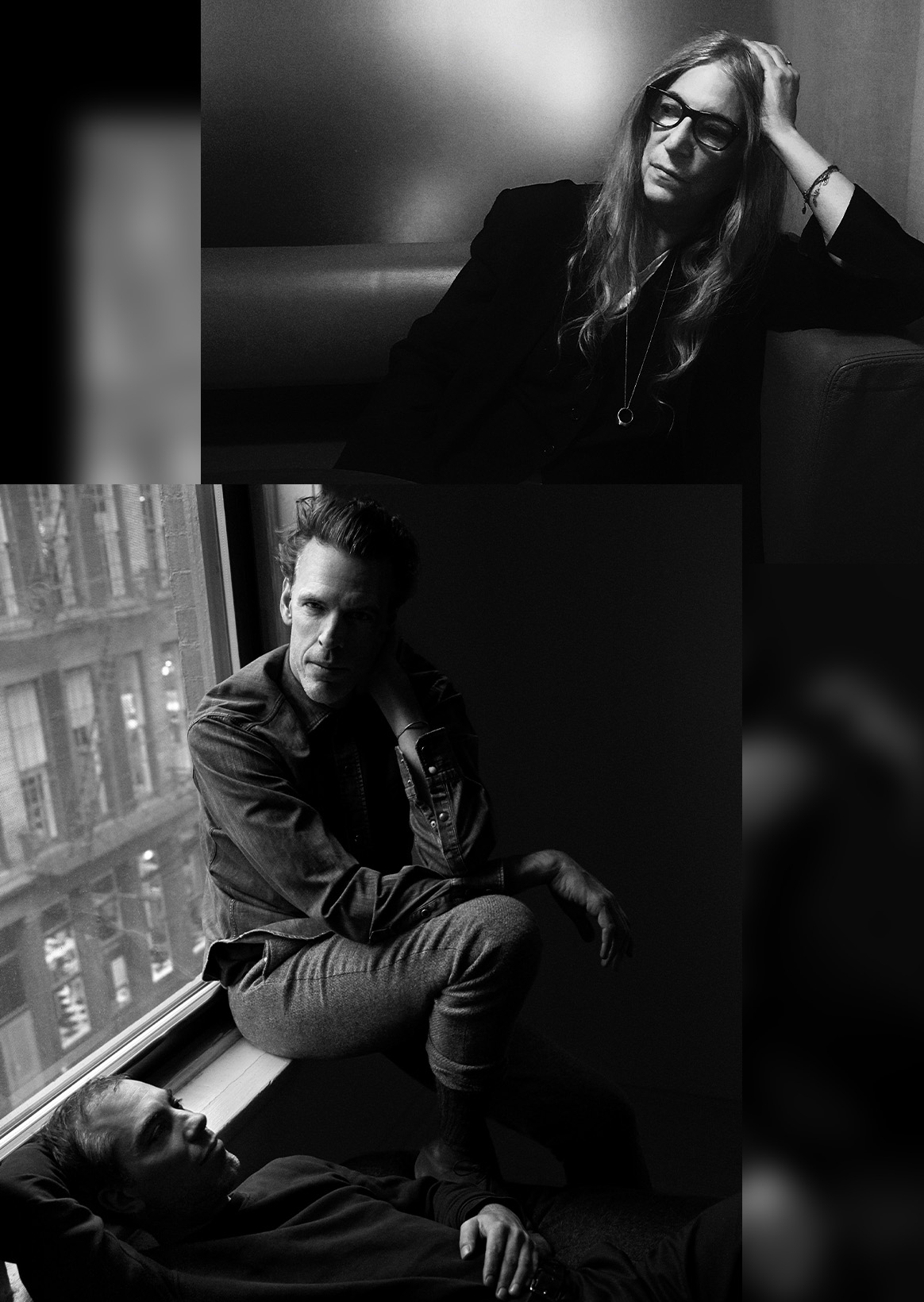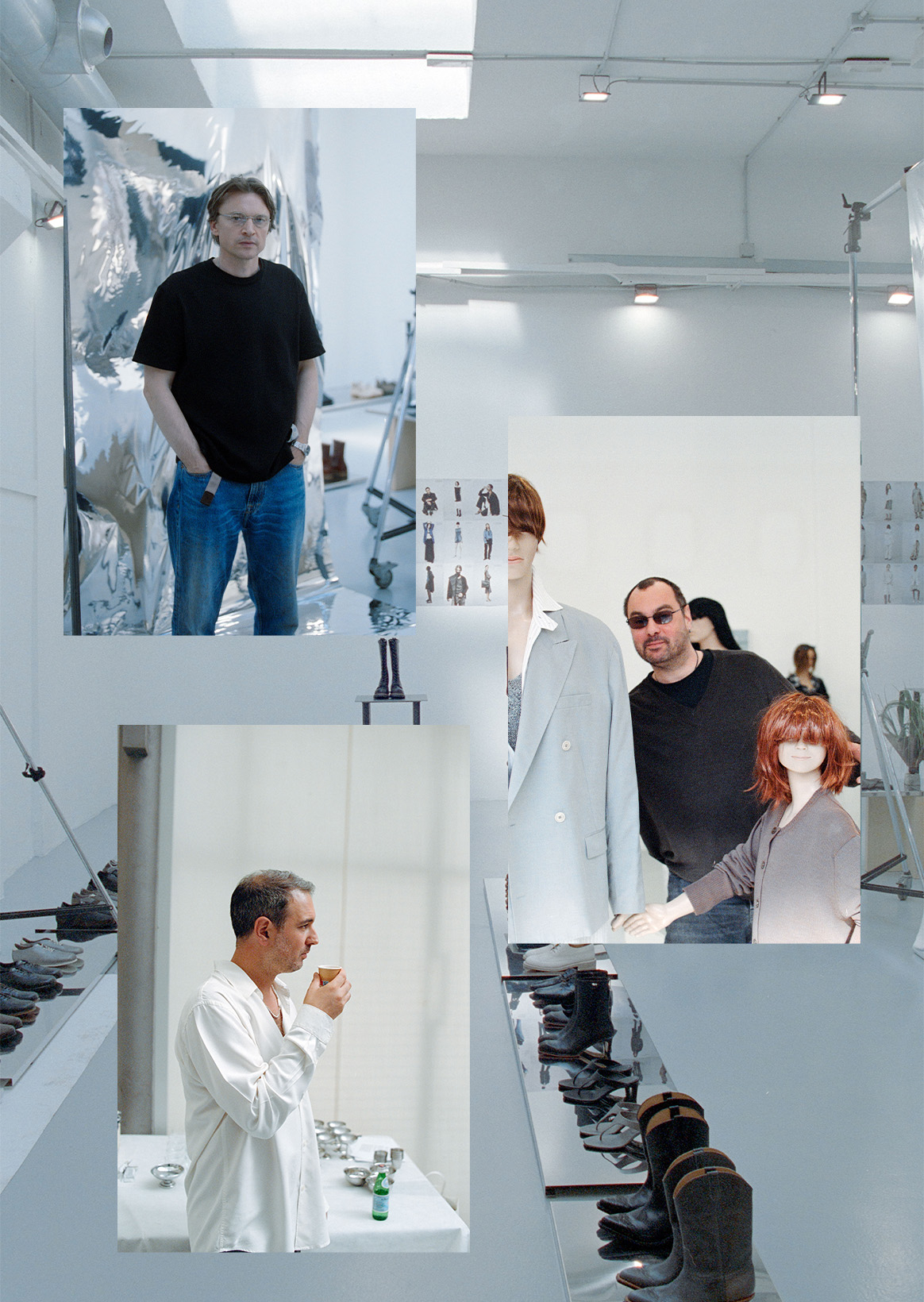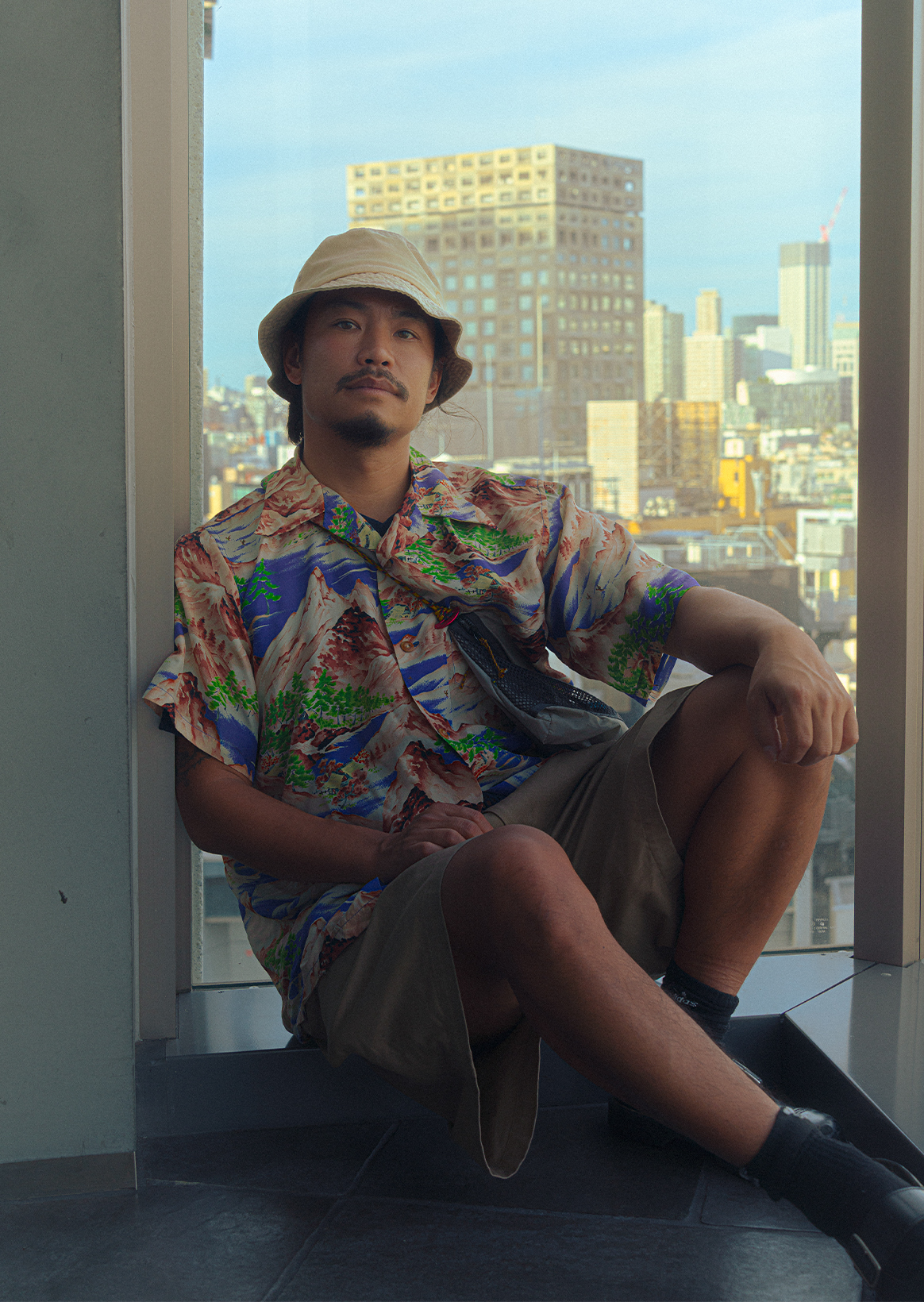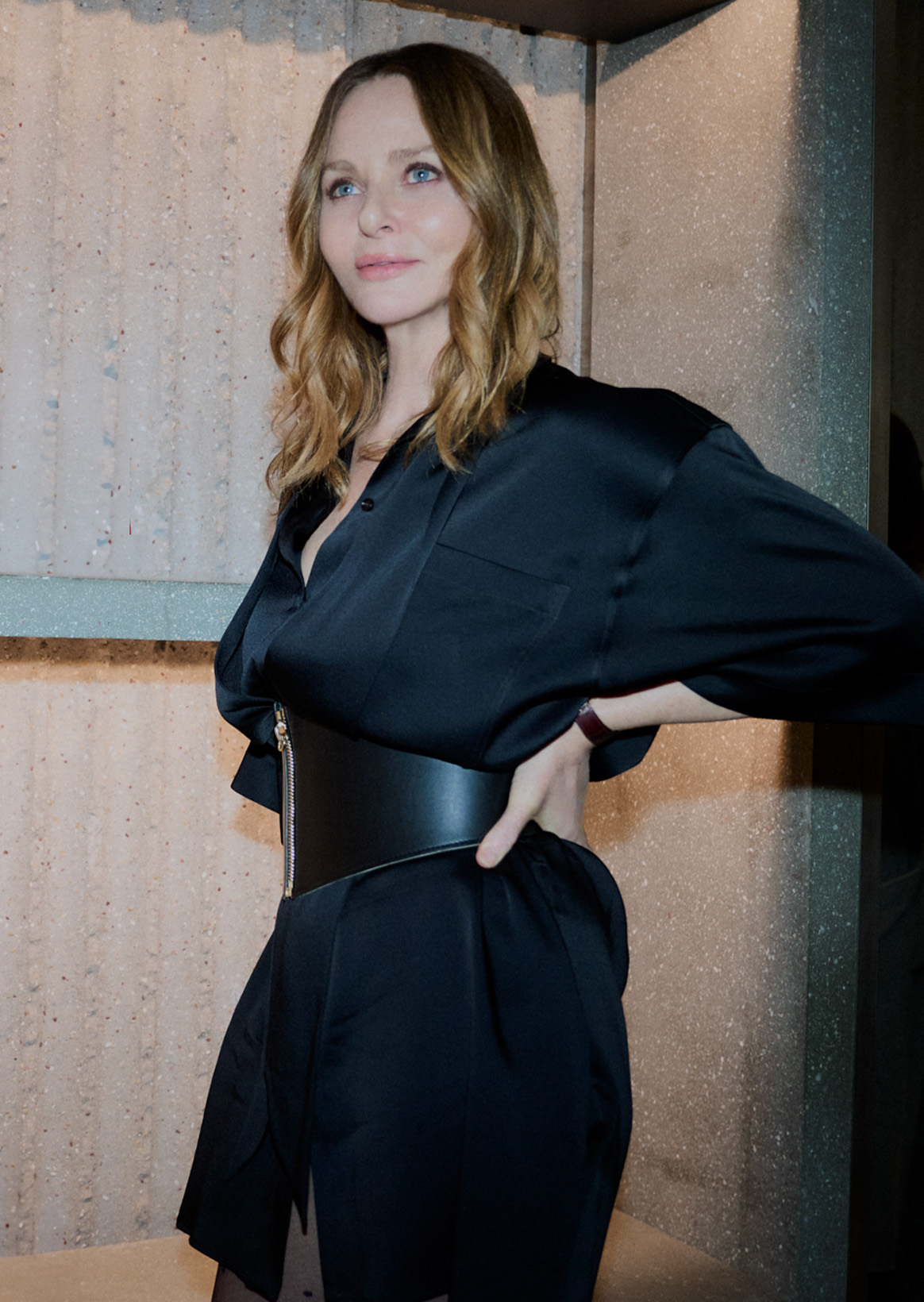A soundwalk collective of international cultural icons, artist and poet Patti Smith, and a contemporary acoustic art group based in Berlin. "Corespondence" is being held at the Museum of Contemporary Art Tokyo, a project born from a dialogue between Soundwalk Collective and Patti Smith for more than 10 years. In the installation works on display, memories of sounds collected from all over the world, poems written by Smith, and images corresponding to them form a space that resonates with each other. Eight images explore themes such as nuclear accidents, forest fires, and animal extinction, listening to the voices of past artists and revolutionaries, and questioning the role of artists and the essence of human beings. How did this long collaboration start and how did it inspire each other? Patti Smith and Stephane Krasniansky of the Soundwalk Collective talked through email about their journey and their approach to creation.
- Text
- Tomoko Ogawa
- Edit
- RIDE Inc.
 Soundwalk Collective & Patti Smith ‘Correspondences’ - kurimanzutto NY (installation view), courtesy of kurimanzutto
Soundwalk Collective & Patti Smith ‘Correspondences’ - kurimanzutto NY (installation view), courtesy of kurimanzutto
ー How did the project "Corespondence" start and develop?
Patti Smith (hereinafter, Patti) It started in the plane above the sky. We were originally strangers, but we began conversations about poetry and sound. Stephane was working on a project that combined Nico's poems with thousands of koolog sounds, and I naturally called out to "help me." We were able to work together in a very good way, so we decided, "Let's continue this." The collaboration began in the sky, and even after landing on the ground, it spread as if it were guided. We are both grounded beings, full of imagination and curious. That balance evolves without stopping the work. There has never been a "end" to our creations.
ーHow are each role and process shared and inspired in each other in creation?
Stephane Krasniansky’s “Corespondence” creative process with Patty is based on the idea of delivering “postcards of invisible landscapes” to her from the first time she worked together. She can walk around the scenery of the sound while in the studio.
"Corespondence" has two different streams. One is the dialogue that Patty has been going on for more than 10 years. New York, Berlin, Paris……We walk around cities around the world together, talk in cafes for a long time, and wander without hesitation. In French, this is called flânerie. As Baudelaire used to walk without a destination, just like “lost” yourself. Such free steps also lead to the rhythm of conversation. While talking about art, poetry, film, creative process, the state of the world, the conversation itself is an inspiration for me when I travel alone. The story of my journey is also an inspiration for Patty. If you bring back stories like “I’ve done field recordings in Chernobyl” or “I’ve traced media footsteps in Georgia,” then that’s the seed of her creation. Therefore, at the core of this project there are many “Franuls”.
The other way is my own journey. For field recording, we will go to the site without any special purpose. I regard the act of "listening" as the practice of "being here now." Even if you go to the site with the idea of wanting to record something, you can't usually record what you thought. I realized that field recording was an experience of letting go of ideas and expectations. Of course, there are built ideas that can be a reason to go to the place in the first place, but if you stick there, you will eventually forcibly create something and you will not be able to accept the process honestly. I just feel "I should go here" and leave myself to that place. While going to the same place many times, such as the Amazon and the desert, we gradually build relationships with sound. Then take back hundreds of hours of recordings, listen back to them in the studio, edit them, and layer layers. The resulting "map of sound" will be the starting point for Patty's creation. She comes to the studio with the "invisible sound landscape". And while walking in the sound, I improvisedly write poetry. After that, they listen again, rewrite, re-record, and finish the track together while repeating the layers of poetry as color. It's like a painting process. First, there is a sound as a "grid", where Patty's words are repeated, and it is built more carefully. It can take years to work. Re-recording, reorganizing, adding instruments, and sometimes she sings. It's a very long process.
Many of the things you can hear and see in this project also record the process of "paving the way in the forest". This idea of “going through the forest” is one of the themes we often talk about. They cut the trees and go backwards. But sometimes it’s just a road that doesn’t get anywhere, “Holzweg,” or “The Woodman’s Way.” But the important thing is not the process of going through the forest, not the destination. If you cut a tree and go into the back, find something meaningful, something heavy, or something “something” we were looking for, that’s enough.
Patti Stephane and many of the places I choose are not easy to reach and sometimes become severely restricted journeys. For most of these journeys, Stephane walks alone. Chernobyl, the sacred mountains of India, the Mexican caves, the stream of the Amazon. He will come back with the sound of the land. Whispering of the wind, the voices of birds and animals, the footsteps of the ice, the sound of glaciers. When I hear these sounds, stories, words, thoughts, and sometimes small songs come naturally in me. The sound specific to such places is like a gift. For example, Stephane traveled to Greenland and recorded the sound of glaciers melting down, the sound of water dripping, and the sound of groaning wind. When I heard the sound, I felt deep sorrow for the change of nature, and it emerged as a story. Loneliness, coldness, and such feelings appear quietly. That sound draws my own confession. In addition to inspiring, it also enhances the power of improvisational expression, and is a means of sharing opportunities to think about environmental changes with others.
The role is clear to some extent. Stephane travels, gathers materials, and undertakes the physically heavy parts. He goes to the deserts and volcanoes, and returns with stones and specimens that I can find inspiration. My role is more concerned with voice. She writes poems, stories, monologues and songs, and delivers them in her voice. We will also provide voice to Stephane's video work as a narration. Drawing is also a personal expression of his own, but when his team is planning an exhibition, he can make suggestions or make adjustments. Our work is collaborative, but we all have our own talents.
 Soundwalk Collective & Patti Smith ‘Correspondences’ - kurimanzutto NY (installation view), courtesy of kurimanzutto
Soundwalk Collective & Patti Smith ‘Correspondences’ - kurimanzutto NY (installation view), courtesy of kurimanzutto
What do you think about the relationship between "sound" and "memory"?
There is not much to see patty sounds tied to so-called personal memories. It's not like Proust's Madeleine. Sound takes me farther away, for example, to the memory of my ancestors and to the civilization of my imagination. I feel that it is sometimes ancient and futuristic. If it is connected to memory, it is a song. Such music, such as old rock and roll, R&B, and Bob Dylan's songs, touches the depths of my heart. However, "pure sound" has another power. The sound of a sad train, for example, can evoke some memory, but even more, it shakes deeper sources of emotions and imagination. For me, sound is more connected to "imagination" than memory.
Stephane: I think the relationship between sound and memory is, in a sense, a very “Proustian” concept. It is similar to taste, smell, or smell experience, and comes straight without filtering. It often appears like a gift from God, evokes memories of the past that were buried in childhood. Or it can bring a sense of "dejav" that evokes memories that do not know where they come from. Sounds reach directly into the brain of emotions and have the power to touch our core. So I'm very interested in the sound that awakens memories. What attracts most when traveling and recording the world is the idea that sound creates a "bridge" with others, people who have already left the world. For example, the sound of rain falling on leaves in Africa, the sound of wind blowing through rock gaps in Mexico, or the footsteps of your own. These sounds have always been there and have not changed. Those who walked there hundreds or thousands of years ago would have heard the same sound. Imagine how the sound reached them and what kind of spiritual space they created.
Sound creates a different experience for each one. It relates not only to personal memories but also to collective or previous-life memories as human beings, so to speak, the human experience itself that has continued since ancient times. Hearing is one of the oldest of the five senses and an important tool for humankind to survive. Therefore, the act of "listening" is a very deep activity. It is the first human connection to Earth, and it is also the connection to animals and other creatures. Of course, the range of hearing varies from species to species, and the range of sounds that humans can hear is limited. However, it makes me think that there is a "collective memory" in the limited amount. In this era, our surroundings are always full of sound and very busy. That's why it's hard to really listen to your own voice and the sounds of the world. To really listen, you need some kind of “training” or “returning to silence.” Of course, I know that there is no "silence" in the absolute sense. Still, there is a lot of information and memories that can lead us to a deep place.
How do you think the balance between "intuition" and "constructed ideas" as an artist is maintained?
Patty In me, I don't divide them clearly. Creation is made up of a natural flow for me, and it blends so that everything is woven together. Whether you draw, play, or write, part of it is rooted in technology, but the other part comes from imagination. I think everything is organically and naturally born.
Stephane As I mentioned earlier, in field recording, multi-layered sounds exist at the same time, overlapping and interfering. And in the future, you have to think about which sounds will be part of the grammar when you compose. What I am looking for in creation is to create new possibilities by combining different realitys. For example, if you were looking for a sound, another sound suddenly appeared. The combination of these two realities leads to the third reality. This is also to open a channel into an area beyond control, a space beyond being present, with a sense of having a "third eye" in a sense. I think the creative process is to bring all these things to the surface. If you compare it to a lake, it is like you can see the depth and bottom of the lake only when the water surface becomes very quiet. Even in field recording, the core and clarity of ideas come only from being there and the act of silence. Intuition leads us to “go to the place to look for something,” and the process of creation is the experience that takes place after that, with the clarity of the mind, and the emergence of what you are looking for. When you create a song with "Corespondence", what you are looking for is the connection between different times, times, people, and souls. At the same time, there is also a connection between myself and the world living as a modern artist. This work is a place for dialogue between the past and the future, as well as a place for observation and introspection. I'm looking for something that touches the heart, something that reaches the soul, and something that goes beyond time.
How does Stefan perceive the attitude of Patti Smith to continue to create while accepting “chaos”?
What Stephane Patti Smith is really wonderful is that he does not fear chaos with courage and boldness, accepts it and tries to face spirits, souls, or places where we normally would not step in. It takes courage to face chaos. It is also called the "third brain", but the rational brain always tries to understand chaos and find order. We have built every habit and structure to control chaos. And I think the experience of letting go of control is, in a sense, an experience of death. A true artist has the courage to jump into that place.
How do you accept “chaos”?
Stephane In my own case, I often associate "let go of order" with the desire to "stop seizing things with my own life experience alone". There are many layers of reality that are infinite around us, and we seek stability in it with a rational mind. However, the natural world is where order and chaos always coexist. This reality in which we humans live is very "human" and limited, but outside it there are countless spiritual beings and sensations that live in chaos. It is there that everything is constantly being dismantled and rebuilt, and in that chaos there is a point of contact with other beings beyond our physical experience: humans, animals, and atomic beings.
When I go out for field recording, I often think about animals, plants, stones, and earth spirits. Everything is “breathing” in a sense, and their reality is much wider and deeper than ours. The means of access to that reality are very limited, and I think that only a small part of the five senses can be captured. But one of the paths beyond that limit is "let go" and "being present at this moment". By doing so, you may be able to get a glimpse of the moment of “co-existence” with other realities for a short time. Through this experience, you can immerse yourself in the possibility of living together with all forms of life. Because there is something in our life experience that is atomic and universal. Each cell and every thought of the body is engraved as a collective experience.
--Pati Smith's reading and singing voice has an overwhelming prayer-like strength. Is there anything you are aware of when dealing with words?
Whether you sing a patty, reading a poem, or just speaking, it’s all about doing “to connect with people.” I touch the most sincere and cleanest part of myself, and draw out the words from it. It is all dedicated to people. I think the expression of prayer is exactly right. Pope Francis said, “Don’t pray like parrots. I once said, “Speak heartily,” but I feel that performance should be like that. We deliver each voice and word as a gift, like a sincere prayer. That's the expression for me. Every performance is as if it was the first time. To meet the people who listen to it with the whole body.
ー SWC and your ALBUM are like hymns, sound like communication with nature, past, present and future, and feel therapeutic effects. What do you think about the therapeutic effects of music?
Patty is a very nice point. I think this is because we are calling for nature in the past, present, and future. We shape sound while listening to our Creator, our connection with the Earth that nurtures us, and our spiritual aspects. I believe that what is created with balance and love has the power of healing. Music not only brings healing, but it can also encourage revolutions, inspire people, and calm the mind. Music is the most abstract form of communication. Even without words, it reaches the senses and emotions straight. I think this power is the essence of music.
Stephane Much of our work aims to “dialogue” nature, ancient memories, and the poets and artists who have existed in the past. They also record where they used to live. Recording in these places is a dialogue with the soul of the past, as well as a dialogue with one's own soul. His work on forests, ecosystems, and extinct species is also a dialogue with the people living today, that is, all of us. At the same time, it is also a dialogue with the past beings who have witnessed this world. In these dialogues, there are the intents of “awakening emotions,” “evoke memories,” and “invoking past and present art, poetry, and words.” It also involves asking questions about the nature of the future and the reality of nature.
As for the healing aspect, I think it's very subjective. If you can create a good work, people who listen and see it will be taken to a place where they “feel” something, moved or inspired. I think that's important. Instead of the word “healing,” what we are looking for may be “inspiration.” To put something into action, to stand up for your rights, to create. Whether it’s writing poetry, doing field recording, or playing music. It is what we aim to promote such creative reactions in "correspondence". In other words, it is to shake people's hearts and evoke the impulse to creation. Everyone must have experienced that feeling once. After seeing wonderful paintings or listening to music that touches your heart, you must have thought, "I want to do something too." What I feel is very important in working as an artist is to mediate “something we all have” and to open communication lines with others through it. It is a line that continues all the way back in the history of mankind.
Your work also includes respect for the deceased and the artists of the past, but how do you perceive time and existence?
Patty: During my creation, I do not deeply analyze the concepts such as "time" or "being". Such considerations may be more likely to be done by receiving the work. What I really feel is that I love living. I also love the works created by others. Joseph Beuys, Tchaikovsky, Tarkovsky, Maria Callas……Their work has made my life many times richer. When I touch such a soulful work, I would like to take the existence firmly and respond with respect. The interpretations and homages we offer are also forms of gratitude that cannot be expressed in words. And in fact, I think that the feeling of "thank you" is something that I can't tell no matter how many times I tell you.
Stephane: Those who have died will live as long as we talk about them, read their works, and remember them. So, I think it's always important to remember our ancestors and the artists we've walked with. If we are doing a good job, as I said before, we are walking in the woods. The idea of the Woodman's Way, the concept of "nowhere to go" as Martin Heidegger wrote in his later years, is that we go deep into the darkness of our soul and step further into the experience of being human. However, I think that the creative efforts of humans have not changed much from the time of cave paintings to the present in the past 30,000 years. I have always felt the need to worship and express the world that surrounds us, and I have remembered those who have sacrificed for us. If you look at the cave murals, you can see that they often worship animals that have dedicated their lives to hunting. This is for other people to survive. The same goes for music and the trucks we make. These honor the poets and artists who appeared before us and paved the way, and as long as we continue to work, they will continue to live through us. And we also hope that through our work, we will be inspired by future artists.
 Soundwalk Collective & Patti Smith ‘Correspondences’ - kurimanzutto NY (installation view), courtesy of kurimanzutto
Soundwalk Collective & Patti Smith ‘Correspondences’ - kurimanzutto NY (installation view), courtesy of kurimanzutto
ーーWhat will the exhibition in Tokyo, which started in New York and traveled through Seoul, look like?
Stephane The exhibition opened in New York earlier this year was the result of work in various parts of the world, such as the Black Sea in Georgia, South America, Africa and Mexico. "Corespondence" exhibited in Tokyo contains works from the past 10 years. It was with Patty's journey from his 70s to nearly 80s. We position this project as a long introspective journey to explore what is an artist. I often call this "late Rembrandt period of Patty". As she often says, as Rembrandt did, she is searching for weights and textures while hiding in the depths of darkness and the richness of light. What are human beings, what are artists, and how do we deal with the environment? I’m still looking for “connection” to that question.
The works brought to Tokyo include new elements, site-specific works. These works are a homage to "Resilience". At the exhibition, a series of images depicting shadows and ghost images that have been soaked through a blank page of the book will be exhibited. We’ve collected pages like this for years and reprinted them on Japanese handmade Japanese paper. The work on display will be written by Patti Smith on top of it. This series questions the nature of ghosts and souls, as well as the connection with radiation and nuclear power. In a sense, it is related to Nagasaki, Hiroshima, and even Fukushima, and of course it resonates with the work of Chernobyl that we have done. In connection with the print, the garden of Sanuki Stone, a rare volcanic stone on Shikoku Island, will be exhibited. This stone has been used for rituals in Buddhist culture, especially in Shinto temples, to create unique resonances. For "correspondence", we collected these stones left behind after making the instrument, and created arrangements arranged as "ghost stones" that express the shell of the instrument and the negative space. These stones are the "carcass" of instruments and symbolize tranquility. In other words, the garden to be exhibited at the Tokyo exhibition is a quiet stone garden.
 Mathilde Brandi, taken at Kurimanzutto gallery NYC 2025
Mathilde Brandi, taken at Kurimanzutto gallery NYC 2025 






Information
From April 25, 2025 (Friday), the BGM of Shibuya PARCO will be selected as a playlist selected by Soundwalk Collective.

Exhibition
MOT Plus "Sound Walk Collective & Patti Smith|Corespondence"
Exhibition Period
April 26 (Sat) to June 29 (Sun), 2025
10:00-18:00 (gallery space entry until 30 minutes before closing)
Closed Days| Monday (open on May 5) / Wednesday, May 7
Venue
Museum of Contemporary Art Tokyo, gallery space B2F
〒135-0022 4-1-1 Miyoshi, Koto-ku, Tokyo Map
Admission fee
General 1,800 yen (tax included) / Free for elementary school students and younger ※Children under elementary school age must be accompanied by a guardian.
Exhibition website
https://www.mot-art-museum.jp/exhibitions/MOTPlus-correspondences/
Official SNS
Instagram(@mot_museum_art_tokyo)X(@MOT_art_museum)

April 29 (Tuesday/holiday) performance in Kyoto
KYOTOPHONIE in collaboration with MODE
Soundwalk Collective & Patti Smith | Chorespondence
On April 29 (Tuesday/holiday), the first day of Golden Week, two performances of "Corespondence" in Japan will be held at ROHM Theatre Kyoto South Hall. This performance will be co-hosted with MODE as a program for "KYOTOPHONIE Borderless Music Festival 2025 Spring", a sister event of "KYOTOGRAPHIE Kyoto International Photography Festival 2025", which will be held from April 12 to May 11, 2025.
Date and time of performance
April 29, 2025 (Tuesday/holiday)
[Lunch Performance] 12:00 Opening / 13:00 Opening
[Night Performance] 16:30 Opening / 17:30 Opening
Venue
ROHM Theatre Kyoto South Hall
〒606-8342 13 MAP of Okazaki Saishoji-cho, Sakyo Ward, Kyoto City, Kyoto Prefecture
Ticket prices (advance sales and tax included)
SS seat designated 20,000 yen
S seat designation 11,500 yen
A seat designated 9,500 yen
B seat designated 5,500 yen ※Preschool children are not allowed
※Elementary school students and above ticket required
※We will not cancel, change, or refund after ticket purchase
Ticket sales
[eplus] https://eplus.jp/correspondences/
[Off-store sales] FamilyMart Store (Maru Chicopee in-store)
[How to purchase over-the-counter] https://support-qa.eplus.jp/hc/ja/articles/6638367888665
[Final first-come first-served]
From 10:00 on March 8, 2025 (Sat)
Official website
MODE: https://mode.exchange
KYOTOPHONIE: https://kyotophonie.jp/
Inquiries about performances
KYOTOPHONIE Secretariat: [email protected]
―
【Additional Tokyo performance decision】
May 2nd (Fri) Tokyo Performance
May 3 (Sat./holiday) Tokyo performance
MODE 2025
Soundwalk Collective & Patti Smith | Chorespondence
The event series "MODE", which introduces experimental music, audiovisuals, and performing arts, invites a performance in Japan for "Corespondence". The Tokyo performance will be held at the New National Theatre, a theater dedicated to opera and ballet in Japan.
Held at Opera Palace. This performance will be the largest performance in MODE history.
Date and time of performance
Friday, May 2, 2025 18:30 Opening / 19:30 Opening
May 3, 2025 (Sat./holiday) 17:00 Opening / 18:00 Opening
Venue
New National Theatre Opera Palace
〒151-0071 MAP 1-1 Honmachi, Shibuya-ku, Tokyo
Ticket prices (advance sales and tax included)
SS seat designated 20,000 yen
S seat designation 11,500 yen
A seat designated 9,900 yen
B seat designated 7,700 yen
C seat designated 5,500 yen ※Preschool children are not allowed
※Elementary school students and above ticket required
※We will not cancel, change, or refund after ticket purchase.
Ticket sales
[eplus] https://eplus.jp/correspondences/
[Off-store sales] FamilyMart Store (Maru Chicopee in-store)
[How to purchase over-the-counter] https://support-qa.eplus.jp/hc/ja/articles/6638367888665
[Final first-come first-served]
From 10:00 on March 8, 2025 (Sat)
Official website
MODE: https://mode.exchange
Inquiries about performances
MODE: [email protected]

Soundwalk Collective
The Soundwalk Collective is a contemporary acoustic and artistic collective led by artist Stephane Krasniansky and producer Simone Merri. In collaboration with artists and musicians, we develop sound projects according to location and situation in order to verify concepts, literature, and artistic themes. He has long-term collaborations with artists such as Patti Smith, film director Jean-Luc Godard, photographer Nan Goldin, choreographer Sasha Waltz, and actress and singer Charlotte Gensbourg. Their practice ranges from art installations, dance, music and film, and by treating sound as a poetic and touchy material, it is possible to connect different media and create a multi-layered story. Laura Poitras, who won the Gold Lion Award at the Venice International Film Festival in 2022, produced an original soundtrack for "All of Beauty and Slaughter". He has exhibited and performed at the Pompidou Center (Paris), Documenta (Cassell), Kunstwerke Center for Contemporary Art (Berlin), New Museum (NY), etc.
https://soundwalkcollective.com
Instagram(@soundwalkcollective)

Patti Smith
Patti Smith was born in Chicago in 1946 and grew up in southern New Jersey before moving to New York in 1967. Since debuting in the innovative ALBUM Horses (1975), which combines poetry and rock, he has influenced numerous artists and musicians and is known as a global cultural icon. His achievements in music, writing, performance, and visual arts have been highly regarded in various fields, including four Grammy nominations, and Haoses is on the National Register of Important Records of the Library of Congress. He has also been active as an artist in photography, painting, and installations, and has exhibited at galleries and museums around the world. In addition to the best-selling memoir "Just Kids", which won the National Book Award for his work, there are many such as "Wol Gathering", "M Train", and "Prediction of innocence". He was awarded the Pen/Faulkner Prize in 2020 and received an honorary doctorate from Columbia University. In 2022, she was awarded the French Legion Doneur Medal in honor of her lifelong achievements.
https://www.pattismith.net/
Instagram(@thisispattismith)
